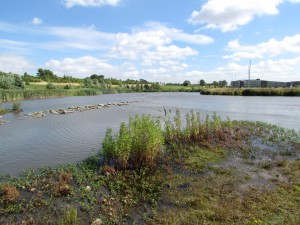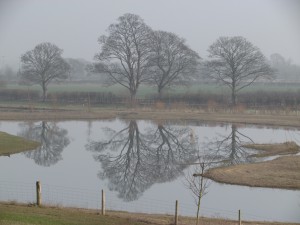Heslington East, University of York
“Hes East” is the newer, eastern campus of the University of York, to the east of Heslington village. It attracts a wide variety of birds, particularly waterfowl, waders and gulls, but also a good selection of other birds as the woodlands, meadows and waterside vegetation mature.
The site is also increasingly important for rarer plants (including orchids of several species), butterflies and dragonflies.
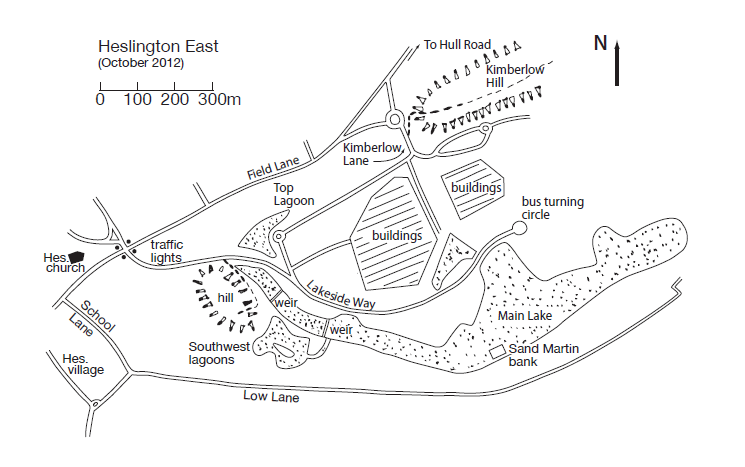
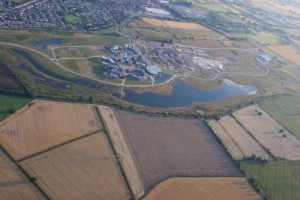
Habitat
The site is now 15 years old, and still developing. Before 2009 it was arable farmland. Drainage for the new campus required the creation of a large lake (1.2km long), deliberately shaped to be ‘wildlife friendly’ with a large Southwest Lagoon, shallow margins almost everywhere, and deeper central areas. The landscape round it was sown with wildflowers, to create meadows, and over the site as a whole about 50 thousand trees were planted. The Top Lagoon lies on the northern edge of the site, and both it and the Main Lake now have extensive Phragmites and Typha reed-beds.
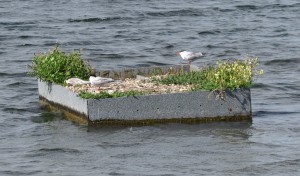
Bird life
The site attracts large numbers of breeding, passage and wintering ducks and geese. Cormorants, Grey Herons, and Little Egrets are regular visitors, and increasingly Great Egrets. Little and Great-Crested Grebes breed. Gulls use the site all year, and rarer species turn up occasionally. In the early days the bare lake shore attracted significant passage waders, but as the shores have grown over these have declined; never-the-less Green Sandpipers, Common Sandpipers, Common Snipe and Jacksnipe are all recorded annually. Oystercatchers breed on one or more of the flat-roofed buildings on the north shore. There are two artificial Sand-martin banks on the south shore with over 70 occupied burrows in 2017, but at the time of writing (2023) the population appears to have collapsed. The open ground and remaining areas of waste ground also attract significant numbers of breeding, wintering and migrant passerines, including Wheatears, Meadow Pipits, Skylarks and Wagtails. The extensive reed-beds host a thriving breeding Reed Warbler colony, several pairs of Reed Buntings, and at least one pairs of Cetti’s Warblers. As the woodland planting matures, it has been colonised by breeding Willow Warblers, Chiffchaffs and Blackcaps. There is an active University Ringing Group (using mist nets), with nearly 50 species ringed on the site over the last few years.
Since 2009 several ‘good’ scarcer species have turned up (e.g. Black-winged Stilt, Black Tern, Little Gull, Common Scoter and Savi’s Warbler).
Other Wildlife
The meadows support a good range of butterflies; particularly notable are Common Blues and small populations of Southern Brown Argus. As well as Small Skippers, Essex Skippers have recently colonised. Dragonflies and Damselflies are increasing as the lake matures, and include Willow Emeralds, Migrant Hawkers, Common and Ruddy Darters, Emperors and Black-tailed Skimmers.
Access
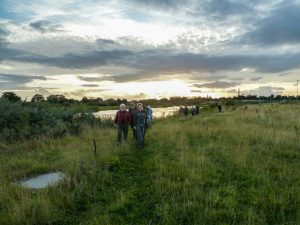
The south shore of the lake is closed to the public, but virtually all the lake can be viewed by foot or by bicycle from the north shore by following the road that runs inside the campus from Heslington village to Kimberlow Hill. You can leave the road in most places on foot to gain access to the lake shore. There are entrances to the road at the western (Heslington) end (SE630 506) and eastern (Kimberlow Hill) end (SE637 509). There is a small parking area on the road in front of Heslington Church (limited to 2 hours Monday-Friday 08.00-18.00) and pay-and-display car parks off Kimberlow Lane that can be used at the weekend for free. The numbers 66 and 67 buses from York stop at Heslington Hall, which is a five-minute walk from the western entrance to the site via the cross-roads and traffic lights just past Heslington Church (which you will see across Church Field as you get off the bus). Or you can stay on the bus and get off at the eastern (Kimberlow Hill) bus stop, from where you can see the lake in the distance. These instructions recommend starting the western (Heslington) end.
As you walk to the site past Heslington Church (or get out of your parked car) head for the cross-roads and traffic lights ahead of you, and cross over to the right-hand (Deramore School) side of the road. Just before you get to the paved road into the campus at the traffic lights, turn down a field path to your right (immediately after the Lord Deramore school playing fields on your right) and walk south past the developing woodlands and meadows to reach a viewpoint overlooking the Southwest Lagoon; unfortunately, the hide there is now permanently locked because of vandalism.
Leave the hide-area and follow the lake shore round to your left, birding as you go, to join the road through the campus, and turn
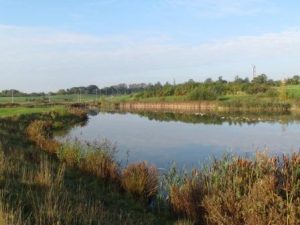
right down the road. In a few 100m it takes you to the Top Lagoon on your left. Having checked the lagoon, continue towards the new college buildings ahead of you (preferably along the lake shore, not on the road itself). You will soon have to rejoin the road and stay on it through the buildings (the most boring part of the walk) to come out just north of the lake which you can then follow all the way along the shore until you reach the far eastern end.
Between the eastern end of the lake and the Sport Village in the distance is an area of rough wet, scrubby ground on the north side of the road, worth checking out. From there you can head up over Kimberlow Hill giving good views over the Vale of York (it looks good for raptors, but usually disappoints) and then head back to Heslington Church, which you can see in the distance.
John Lawton, revised December 2023
